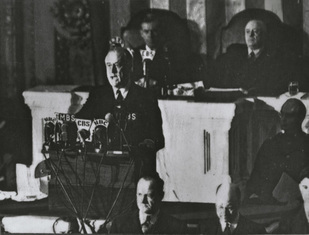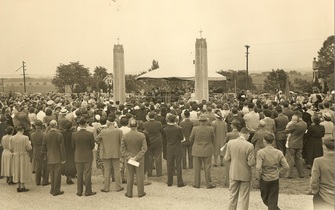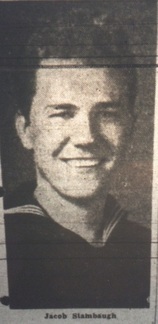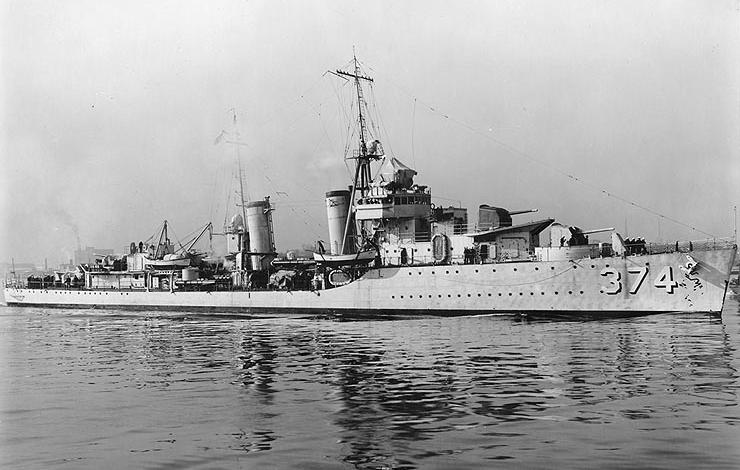 President Roosevelt addresses Congress President Roosevelt addresses Congress Seventy-five years ago, citizens of Frederick listened intently to radios as the following words were spoken by their defiant president, Franklin Delano Roosevelt as he addressed Congress and the nation on Monday, December 8, 1941: “Yesterday, December 7th, 1941—a date which will live in infamy—the United States of America was suddenly and deliberately attacked by naval and air forces of the Empire of Japan. The United States was at peace with that nation and, at the solicitation of Japan, was still in conversation with its government and its emperor looking toward the maintenance of peace in the Pacific. Indeed, one hour after Japanese air squadrons had commenced bombing in the American island of Oahu, the Japanese ambassador to the United States and his colleague delivered to our Secretary of State a formal reply to a recent American message. And while this reply stated that it seemed useless to continue the existing diplomatic negotiations, it contained no threat or hint of war or of armed attack. It will be recorded that the distance of Hawaii from Japan makes it obvious that the attack was deliberately planned many days or even weeks ago. During the intervening time, the Japanese government has deliberately sought to deceive the United States by false statements and expressions of hope for continued peace. The attack yesterday on the Hawaiian islands has caused severe damage to American naval and military forces. I regret to tell you that very many American lives have been lost. In addition, American ships have been reported torpedoed on the high seas between San Francisco and Honolulu. Within an hour of this speech, Congress passed a formal declaration of war against Japan and officially brought the U.S. into World War II. Everyday life would be changed forever. And for many young men of the time, life would be cut drastically short on the seas and islands of the Pacific, battlefields of Europe and deserts of Africa among others.  Dedication of World War II Monument, May 30, 1948 Dedication of World War II Monument, May 30, 1948 As we commemorate this, the 75th anniversary of the bombing of Pearl Harbor, we reflect on those service men and women who put their lives on the line, specifically those connected to the Hawaiian Islands bombings. Over 200 soldiers, sailors and pilots from Frederick lost their lives in World War II. A monument to their memory lies within Mount Olivet Cemetery, originally dedicated on May 30, 1948. The double-columned monument, made of Indiana limestone, features a central obelisk containing the names of 219 individuals from all parts of Frederick County. Atop this pilaster is a sculpted eternal flame of gold, below which read: “The flame of love shall burn into our hearts the memory of our noble dead.” The remains of 30 veterans, who died in the line of duty, are buried in a semi-circular design around the monument, marked by flat, military issue stone markers. One of these slabs of marble rests over the body of Ray Jacob Stambaugh.  Jacob Stambaugh held the rank of fireman/first class Jacob Stambaugh held the rank of fireman/first class Jacob Stambaugh was serving at the United States naval base at Pearl Harbor on the island of Oahu, Hawaii Territory on the morning of December 7, 1941. Commencing at 7:48am (Hawaiian time), the base was attacked by 353 Imperial Japanese fighter planes and bombers launched from nearby aircraft carriers. Luckily, Jacob Stambaugh (fireman/1C) survived the assault without injury. He was stationed aboard the USS Tucker (DD-374), a Mahan-class destroyer assigned to the US Battle Fleet in San Diego, California that routinely operated along the West Coast and in the Hawaiian Islands. Stambaugh's ship had come to Pearl Harbor following a good will tour to New Zealand and was berthed at the East Loch of Pearl Harbor while undergoing overhaul. The ship did not receive much damage, as it was in the position however to shoot down four enemy planes that morning. Born March 17, 1921, Jacob Stambaugh was a native of Jimtown, near Thurmont. He was a former student and standout baseball player who attended the Buckingham School that once operated south of Buckeystown (today part of Claggett Center). He joined the Navy in 1939.  For the months following the Pearl Harbor disaster, Jacob Stambaugh saw duty in other parts of the Pacific. The USS Tucker escorted convoys between the West Coast and Hawaii. She then did escort work to American Samoa, the Fiji Islands, New Caledonia, and Espiritu Santo, New Hebrides. This latter island, today known as Vanuato, is where Stambaugh would lose his life. Newspaper accounts of the time reported that Stambaugh’s death was connected to the Battle of Midway which occurred in June of 1942. This wasn’t so. He was actually reported missing in action in early September, 1942. An article in the Frederick News and dated October 3rd, 1942 confirmed Stambaugh’s death at the age of 21 years of age. He would be the first World War II Naval casualty from Frederick County. I consulted our Mount Olivet records and found a notation in the file that Stambaugh was aboard the USS Tucker at the time of his death on August 4th, 1942, saying he died during the Battle of Midway. I questioned this and went online in search of the USS Tucker. I soon found the following account that documented an event that occurred on August 3, 1942 off the South Pacific island of New Hebrides: “The Tucker entered the harbor at Espiritu Santo's western entrance, leading the cargo ship SS Nira Luckenbach, unaware they had entered a minefield laid earlier by US Navy minelayers. After striking at least one mine, the destroyer was almost torn in two at the No. 1 stack, killing all three of the crew in the forward fireroom. The rest of the crew survived but Tucker did not. The destroyer slowly settled in the water and sank. An investigation revealed that the USS Tucker had not been given information about the existence of the minefield.” Jacob Stambaugh was one of the three men killed that fateful night. He was originally buried in the Espiritu Santo American Military Cemetery located on the US naval base located on the island. Six and-a-half years after his death, Ray Jacob Stambaugh would be repatriated and returned home to Frederick County (summer of 1948), just one week after the momentous dedication of Mount Olivet’s World War II monument. He goes down in the history books as the first WWII Naval casualty from Frederick County, and a lasting local connection to that “infamous day” in early December, 1941. Check out a touching YouTube video featuring vintage film made of a WWII military grave detail at Espiritu Santo Military Cemetery where Ray Jacob Stambaugh was first interred https://www.youtube.com/watch?v=EnksOA4sSeM
2 Comments
Tom Trott Jr
12/7/2016 07:26:46 am
Great work Chris. Thank you for honoring Jacob Stambaugh.
Reply
shane shanholtz
12/7/2019 09:50:30 pm
thanks for the story
Reply
Leave a Reply. |
STORIES
|
Archives
July 2024
June 2024
May 2024
April 2024
March 2024
February 2024
January 2024
December 2023
November 2023
September 2023
August 2023
July 2023
June 2023
May 2023
April 2023
March 2023
February 2023
January 2023
December 2022
November 2022
October 2022
September 2022
August 2022
July 2022
June 2022
May 2022
April 2022
March 2022
February 2022
January 2022
December 2021
November 2021
October 2021
September 2021
August 2021
July 2021
June 2021
May 2021
April 2021
March 2021
February 2021
January 2021
December 2020
November 2020
October 2020
September 2020
August 2020
July 2020
June 2020
May 2020
April 2020
March 2020
February 2020
January 2020
December 2019
November 2019
October 2019
September 2019
August 2019
July 2019
June 2019
May 2019
April 2019
March 2019
February 2019
January 2019
December 2018
November 2018
October 2018
September 2018
August 2018
July 2018
June 2018
May 2018
April 2018
March 2018
February 2018
January 2018
December 2017
November 2017
October 2017
September 2017
August 2017
July 2017
June 2017
May 2017
April 2017
March 2017
February 2017
January 2017
December 2016
November 2016











 RSS Feed
RSS Feed